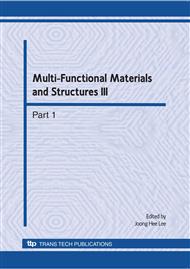p.97
p.101
p.105
p.109
p.113
p.117
p.121
p.125
p.129
Highly Transparent and Conductive Graphene Electrode
Abstract:
The solvent-based exfoliation of graphite, including into graphene and/or graphene-like platelets, is an important challenge. Here, we report a “direct” Friedel-Crafts acylation reaction between graphite and 4-ethylbenzoic acid (EBA) to afford edge-functionalized graphite (EFG). Unlike, for example, graphite oxide (GO), the functionalization is at the edges of the graphite and thus, the basal plane of individual layers in EFG is not functionalized. The EFG can be easily dispersed and exfoliated in common organic solvents to concentrations as high as 0.8 mg/mL. Large-are uniform films can be produced by solution-casting such dispersions on substrates and conductivities as high as 125 S/cm can be obtained by subsequent heat treatment at 900 °C under argon atmosphere. Hence, a few layers graphene obtained from annealing under argon atmosphere show the potential to replace Indium tin oxide (ITO).
Info:
Periodical:
Pages:
113-116
Citation:
Online since:
August 2010
Authors:
Keywords:
Price:
Сopyright:
© 2010 Trans Tech Publications Ltd. All Rights Reserved
Share:
Citation:



